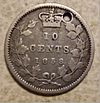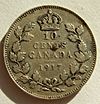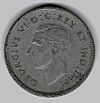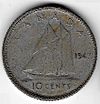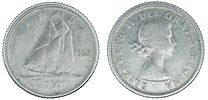Dime (Canadian coin) facts for kids
| Canada | |
| Value | 0.10 Canadian dollar |
|---|---|
| Mass | 1.75 g |
| Diameter | 18.03 mm |
| Thickness | 1.22 mm |
| Edge | Milled |
| Composition | Nickel-plated steel 92% steel, 5.5% Cu, 2.5% Ni plating |
| Years of minting | 1858–present |
| Catalog number | – |
| Obverse | |
 |
|
| Design | Elizabeth II, Queen of Canada |
| Designer | Susanna Blunt |
| Design date | 2003 |
| Reverse | |
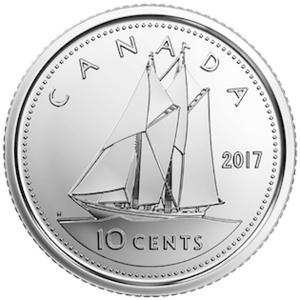 |
|
| Design | Bluenose schooner |
| Designer | Emanuel Hahn; design based on photographs of the Bluenose |
| Design date | 1937 |
In Canada, a dime is a coin worth ten cents. It has been the smallest Canadian coin since 1922. It is even smaller than the old Canadian penny, even though it is worth more. The official name for the coin is the 10-cent piece. However, most people in English-speaking Canada just call it a dime.
The Canadian dime is almost the same size as the American dime. But there is one cool difference: the Canadian dime is magnetic! This is because of the metals it is made from. From 1968 to 1999, it was made mostly of nickel. Since 2000, it has a steel center with layers of nickel and copper on the outside.
Like all Canadian coins, the dime shows a picture of Queen Elizabeth II on the front. This side of the coin is called the obverse. The back of the coin, called the reverse, shows the Bluenose. This was a very famous Canadian schooner, which is a type of sailing ship. The artist Emanuel Hahn created the design for the 10-cent coin. He based it on photos of the real Bluenose ship. The Royal Canadian Mint makes these coins in Winnipeg.
The word dime comes from an old French word, dîme. This word means "tithe" or "tenth part." It comes from the Latin word decima, which also means "tenth."
What are Dimes Made Of?
Dimes have been made from different metals over the years. Here is how their ingredients have changed:
| Years | Weight | Size | What it's Made Of |
|---|---|---|---|
| 1858–1919 | 2.33 g | 18.034 mm | 92.5% silver, 7.5% copper |
| 1920–1967 | 2.33 g | 18.034 mm | 80% silver, 20% copper |
| 1968–1999 | 2.07 g | 18.03 mm | 99.9% nickel |
| 2000–present | 1.75 g | 18.03 mm | 92.0% steel (a type of metal), 5.5% copper, 2.5% nickel plating |
Special Edition Dimes
Sometimes, the Royal Canadian Mint makes special dimes. These are called "commemorative editions." They celebrate important events or anniversaries.
| Image | Year | What it Celebrates | Artist | How Many Made | Cool Facts |
|---|---|---|---|---|---|
| 1967 | Canada's 100th Birthday | Alex Colville | 62,998,215 | This coin shows a mackerel, which is a type of fish. It says 1867–1967 on it. | |
| 2001 | International Year of the Volunteer | Stan Witten | 224,714,000 | This dime honored people who volunteer their time to help others. | |
| 2017 | Canada's 150th Birthday | Amy Choi | 20,000,000 | This coin celebrated 150 years since Canada became a country. It shows a maple leaf that looks like a dove's wings. The coin's theme was "Our Character." It says 1867–2017. | |
| 2021 | 100th Birthday of the Bluenose | Yves Bérubé | 6,000,000 (colour) 9,000,000 (regular) |
This coin shows the Bluenose sailing on the ocean. Some of these coins even have blue color on the water! It says 1921–2021. |
Rare and Unique Dimes
Some dimes are extra special because they are very rare. This makes them valuable to coin collectors.
- 1936 dot: This dime is super rare! Only 5 of them are known to exist. Three are owned by private collectors, and two are in a museum in Ottawa. One of these rare coins sold for about US$184,000 at an auction in 2010.
- 1969 large date: Fewer than 20 of these dimes exist. If you find one in great condition, it could be worth between $15,000 and $30,000!
- 1999p: This was the first Canadian 10-cent coin made with a new "plating" process. These coins have a tiny "P" mark under the Queen's picture. Only 20,000 of these were made.
- 2000p: The 2000p Canadian dime is also very rare. Fewer than 250 of them were made. The Royal Canadian Mint lent these coins to companies to test them in vending machines. The companies were supposed to return them. But many were not returned, making them very hard to find. A high-quality 2000p dime can be worth between $1,500 and $3,000 Canadian dollars.



